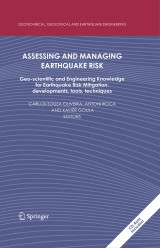Details

Assessing and Managing Earthquake Risk
Geo-scientific and Engineering Knowledge for Earthquake Risk Mitigation: developments, tools, techniquesGeotechnical, Geological and Earthquake Engineering, Band 2
|
213,99 € |
|
| Verlag: | Springer |
| Format: | |
| Veröffentl.: | 04.12.2007 |
| ISBN/EAN: | 9781402036088 |
| Sprache: | englisch |
| Anzahl Seiten: | 545 |
Dieses eBook enthält ein Wasserzeichen.
Beschreibungen
Table 1. 1 reports the world’s largest earthquakes since 1900 with respect to number of deaths (larger than or equal to 10 000), also showing the region of occurrence and the corresponding magnitudes. Both, from Figure 1. 2 and Table 1. 1 it is interesting to note that this period of time is characterized by an annual average of 15 000 deaths with two main fluctuations (modal values), the largest in the period 1900 to 1940 and another with a larger value in the decade of 1970-80. Figure 1. 2 shows the number of total deaths from the greatest earthquakes that occurred in the XX century. Although the number of victims has a tendency to decrease with time, the economic losses are increasing significantly (see Chapter 18 of this book). Table 1. 1. World earthquakes since 1900 with number of deaths greater than 10 000 Year Region Deaths Magnitude Year Region Deaths Magnitude 1905 India 19000 8. 6 1960 Agadir, Morocco 12000 5. 9 1906 Chile 20000 8. 6 1962 Iran 12000 7. 3 1907 Central Asia 12000 8. 1 1968 Iran 10000 7. 3 1908 Italy 70000 7. 5 1970 Yunnan, China 10000 7. 5 1915 Italy 29980 7. 5 1970 Peru 67000 7. 7 1917 Indonesia 15000 - 1972 Nicaragua 10000 6. 2 1918 China 10000 7. 3 1976 Guatemala 23000 7. 5 1920 China 220000 8. 5 1976 242000 7. 8 Tangshan, China 1923 Japon 142807 7. 9 1978 25000 7.
Assessing and Managing Earthquake Risk. An Introduction.- Assessing and Managing Earthquake Risk. An Introduction.- Earthquake Hazard And Strong Motion.- Overview on Earthquake Hazard Assessment - Methods and New Trends.- Observation, Characterization and Prediction Of Strong Ground Motion.- Local Site Effects and Microzonation.- Site-City Interaction.- Vulnerability Assessment.- Vulnerability Assessment Of Dwelling Buildings.- Vulnerability Assessment Of Historical Buildings.- Experimental Techniques For Assessment Of Dynamic Behaviour Of Buildings.- Vulnerability and Risk Assessment Of Lifelines.- System Analysis And Risk.- Damage Scenarios and Damage Evaluation.- Urban System Exposure to Natural Disasters: An Integrated Approach.- Response Of Hospital Systems.- Managing Earthquake Risk.- Building Against Earthquakes.- Industrial Facilities.- Early Warning and Rapid Damage Assessment.- Technical Emergency Management.- Civil Protection Management.- Earthquake Risk and Insurance.- Strengthening and Repairing Earthquake Damaged Structures.- Advanced Techniques in Modelling, Response and Recovery.- Case Studies, Initiatives And Experiences.- Seismic Loss Scenarios Based on Hazard Disaggregation. Application to the Metropolitan Region of Lisbon, Portugal.- Loss Scenarios For Regional Emergency Plans: Application to Catalonia, Spain.- Risk-Ue Project: An Advanced Approach to Earthquake Risk Scenarios With Application to Different European Towns.
<p>This book points out the need of a multidisciplinary approach in the field of risk assessment and management. It provides an overview of the problems, approaches and common practices directly related to earthquake risk mitigation and, in particular, to the preparation of earthquake emergency plans. Written by a team of specialists from different disciplines, the authors worked together extensively in order to create unity and continuity in the text as a whole. Each topic is illustrated with examples of actual applications taken from the bibliography – including websites with available relevant information. Case studies and information on some relevant international projects are given.<br>Audience<br>This work will be of interest to students and professionals with a basic education in geology, geophysics, geotechnical and civil engineering, system analysis, geography and architecture. It can be used as a textbook for a specialized post-graduate course on the topic. </p>
Multidisciplinary approach of risk assessment and management, which can provide more efficient earthquake mitigation Transfer of Geo-scientific and engineering knowledge to Civil Protection and insurance agents Approaches and common practices directly related to the preparation of earthquake emergency plans Illustrated examples of actual applications, including web sites Case studies and information on relevant international projects
<p>Written by a team of specialists in many disciplines, this book answers the need for a multidisciplinary approach in the field of earthquake risk assessment and management. It provides an overview of earthquake emergency plans, and a frank assessment of the problems and pitfalls of current methods. The authors apply real world experience to the transfer of geo-scientific and engineering knowledge to Civil Protection personnel and insurance agents. Also included are examples of actual applications taken from the bibliography – including relevant websites.</p>
Diese Produkte könnten Sie auch interessieren:

Contaminated Soils, Sediments and Water:

von: Edward J. Calabrese, Paul T. Kostecki, James Dragun

149,79 €















